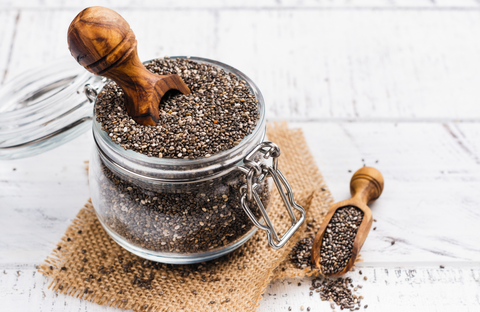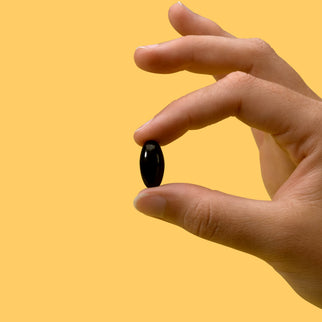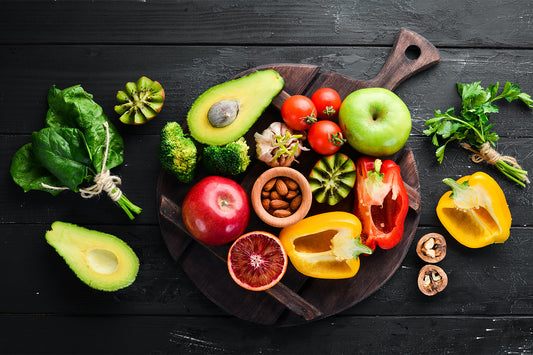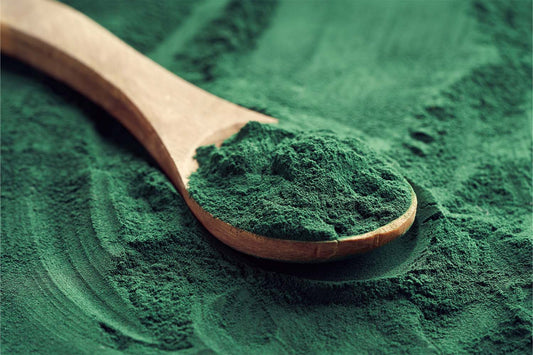You’ve probably heard the amazing potential benefits of omega-3 by now — from supporting a positive mood to supporting a healthy heart. If you have, you’ve probably also heard that foods like chia seeds, flaxseeds, and canola oil are strong sources of omega-3.
However, not all sources of this powerful nutrient are exactly as they seem. In order to understand the best sources of omega-3, it is important to understand what omega-3 is, how it works, and what foods contain it.
What Are the Different Types of Omega-3 Fatty Acids?
Many people strive to get more omega-3 fatty acids because they are marketed as an excellent way to obtain multiple health benefits, but there is more nuance than you might think.
Omega-3 fatty acids are a type of polyunsaturated fatty acid that serves as a building block for cells in the body and influences important bodily functions. This family of fatty acids can indeed provide health benefits, but it may be more complex than consuming any food with omega-3s.
To get the full picture, it is important to understand that there are three main types of omega-3 fatty acids. The three most common forms of omega-3 fatty acids are:
- Alpha-linolenic acid (ALA), a short-chain omega-3 precursor
- Docosahexaenoic acid (DHA)
- Eicosapentaenoic acid (EPA)
Are All Omega-3 Fatty Acids the Same?
Although all of these fatty acids are beneficial in some way, most of the benefits that come with consuming omega-3s come from DHA and EPA fatty acids — not ALA. Both EPA and DHA are considered long-chain fatty acids, and your body needs both for several functions in the body, like building cells in your brain and eyes.
Because of your body’s need for these two essential acids, your body actually uses ALA to convert it into EPA and DHA. However, your body can only convert a small percentage of ALA into DHA and EPA. Studies have shown that the body only converts around 8% of ALA into EPA and less than 4% into DHA in men. In women, around 21% of ALA is converted to EPA and 9% into DHA. Therefore, you are far better off obtaining these essential nutrients from your diet.
The general daily recommended dietary intake for ALA omega-3s for men is 1.6 grams, and for women, 1.1 grams. However, ALA omega-3s are found in many more foods than DHA and EPA, so few people have to worry about getting enough ALA in their diet. On the other hand, experts recommend getting around 250mg of DHA and EPA, which are only found in select foods and are harder to obtain.
So what does all of this mean for the foods that we eat?
How Much Omega-3 Is in Chia Seeds?

Chia seeds have multiple nutritional benefits, as they are rich in protein, fiber, calcium, and zinc. Still, they are best known as an excellent way to get omega-3. In just an ounce of chia seeds, you can obtain about 17.8 grams of ALA. So by definition, chia seeds have a high omega-3 content, but there is a catch.
Unfortunately, the form of omega-3 that exists in chia seeds is not as beneficial as other forms. Chia seeds still offer valuable nutrition with both protein and fiber. These small seeds may help support heart health and promote healthy cholesterol levels — therefore, there are plenty of reasons to incorporate chia seeds into your diet, but they are not the powerful source of omega-3 you are hoping for.
Regardless, you have little to lose by including chia seeds in your smoothie, with some yogurt, or even in salad dressing. Just don’t rely on them to give you all of the omega-3s that your body needs.
Are Flaxseeds or Flaxseed Oil Better Options?
Flaxseeds are an excellent source of nutrients, as they are packed with fiber, protein, vitamins, and minerals.
These little seeds are also the richest source of phytochemicals called lignans, which can produce phytoestrogens and provide some potential positive effects of flaxseed for your heart. Lastly, of course, flaxseeds are known as a great source of omega-3. Specifically, 100 grams of flaxseeds contain 19.4 grams of ALA omega-3.
From ground flaxseed to flaxseed oil, there are many ways to incorporate these nutrient-packed seeds into your diet. Flax seeds can be added to smoothies, used in baking recipes, and even found in bread. Many people consume flax seeds whole, but for the most nutritional benefits, you should turn to ground flax. According to experts, flax seeds pass through many people totally undigested, which means that you receive none of the ALA content you thought you were getting. Flax oil still has some nutritional properties, but it does not contain the same fiber or protein as other forms.
As with chia seeds, using flax seeds in your smoothie or on your yogurt may provide some benefits, but you should not count on them for getting your recommended amounts of omega-3s. Both flaxseeds and their byproduct, flaxseed oil, are similar to chia seeds in that they only provide ALA, which does not offer the same benefits as the other forms.
In addition to these types of seeds, many people also applaud whole grains, nuts, and plant oils, like canola or olive oil, as strong sources of omega-3 fatty acids. Unfortunately, these sources also only include ALA and may not provide the benefits you are looking for. Still, these foods offer other great benefits when included in your diet, providing healthy fats, protein, lignans, and more.
What Are the Benefits of DHA and EPA?
When you hear about the benefits of omega-3 fatty acids on a label, they are almost guaranteed to be the result of DHA and EPA. These essential fatty acids have the most crucial functions in the body. Consuming these two fatty acids provides several possible health benefits, as they can do the following:
- Support overall joint health
- Support a healthy mood and emotional wellness
- Support heart health
- Help maintain overall healthy blood pressure
- Support healthy HDL and LDL cholesterol levels
- Help maintain healthy triglyceride levels
On top of their general health benefits, these two nutrients also play a crucial role in growth in development. For example, DHA can help support healthy growth and development during pregnancy and childhood. DHA is an important building block of cells found in the brain and eyes, so it is a necessary nutrient as these two systems are developing in young children.
As a consequence, women who are pregnant or breastfeeding are generally advised to take more in order to provide adequate nutrition for their growing babies.
Ultimately, because chia seeds and flaxseeds do not contain DHA or EPA omega-3s, they do not offer as many health benefits as you might expect. In order to truly reap the benefits of consuming omega-3 fatty acids, you need to consume foods or supplements that contain these two specific forms of omega-3s.
What Are Good Sources of DHA and EPA?

Now that you know you need more DHA and EPA in your diet, it is important to know where to get these two essential fatty acids. Unfortunately, DHA and EPA are not as abundant in a normal diet as ALA. However, there are still a few key sources that you can turn to.
Fatty Fish
The most common source of DHA and EPA is fatty fish, including salmon, mackerel, sardines, anchovies, and more. Many experts recommend eating two to three servings of fish a week. Although this isn’t the only way to get your omega-3s, it is definitely one of the most popular ways.
However, there are a few drawbacks and risk factors to relying on fish for your omega-3s. These drawbacks include the potential for mercury contamination, the fact that many people are allergic to seafood, and the reality that many people choose to avoid fish due to their lifestyles. For example, people on plant-based diets may choose not to eat fish for its omega-3 benefits.
Fish Oil
Fish oil supplements are probably the most popular source of DHA and EPA omega-3 fatty acids, as they have gained a strong presence on grocery store shelves. You can take fish oil in capsules or by the spoonful, making it much more convenient than cooking fish.
Of course, fish oil has the same drawbacks as eating fish, plus its potent smell can leave you with quite the unpleasant fishy aftertaste as a common side effect.
Krill Oil
Krill oil is very similar to fish oil, except it is made from krill, which are tiny crustaceans found around the oceans. Krill oil also contains considerable amounts of DHA and EPA, but it can be more expensive and harder to find on grocery store shelves than fish oil.
People may choose krill oil over fish oil as it also contains an antioxidant called astaxanthin, which is great for supporting the healthy aging of cells. Although krill oil is another strong source of DHA and EPA, it offers the same drawbacks as fish and fish oil, in addition to other environmental drawbacks. Krill play an important part in the global carbon cycle, and experts admit that they don’t know the full implications of harvesting krill for dietary supplements.
Algal Oil
Algal oil provides all of the benefits of fish and krill oil without the drawbacks — in fact, algal oil may even offer more benefits. For starters, algae is the only plant-based source of DHA and EPA omega-3s, already making it an excellent choice for any lifestyle.
However, those who take algae supplements can experience more benefits than just a healthy lifestyle choice. The DHA and EPA in algae are actually absorbed by the body better than from other sources because of how it is formed. So, when you consume algae, your body absorbs the omega-3s 1.7 times better! As a consequence, your bodily systems are better able to put the nutrient to use.
To top it off, algae is also rich in antioxidants, so it beats out the other options no matter how you look at it. To get all of your recommended DHA and EPA from just one daily softgel, you can take iwi life’s omega-3 supplement and enjoy all of these great benefits.
Source Your Omega-3 From a Reliable Supplement

Omega-3 fats indeed provide valuable health benefits, but it is important to be mindful of where you get them. If you want to include ground flax, flaxseed oil, or chia seeds in your diet, there is plenty of reason to. However, you should still include a dietary supplement that provides you with essential DHA and EPA omega-3s.
For an easy but highly effective option to get your daily recommended omega-3s, turn to iwi life. With iwi life omega-3 supplements, you can trust that you are getting a full 250 grams of DHA and EPA omega-3s. Support your overall health and wellness from your heart to your joints with completely plant-based algae and experience all the benefits for yourself.
Sources:
Lignans | Linus Pauling Institute
Essential Fatty Acids | Linus Pauling Institute
Omega-3 Fatty Acids - Health Professional Fact Sheet | NIH
Seeds, chia seeds, dried | USDA
Flaxseed, ground | USDA
Chia seeds pack nutritional punch | Mayo Clinic Health System
Flaxseed: Is ground better than whole? | Mayo Clinic.
Antarctic Krill: Carbon Conveyor Belt of the Southern Ocean | The Pew Charitable Trusts





















